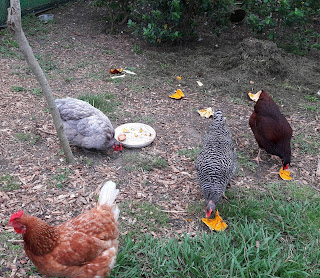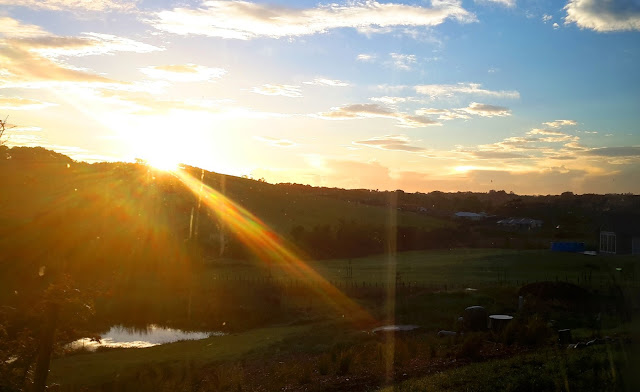Finally
living at Kingfisher cottage on four acres of land, we can develop our long
term dream, part of which is self-sufficiency. In the next decade, we aspire to
cutting or controlling as many living costs as we can. Keeping costs under
control will help us to spend on things that can earn us income in the future,
and give us that warm feeling of independence. We also get to eat and drink
more healthily as a side product of this too! So far we have made easy changes:
living at Kingfisher cottage on four acres of land, we can develop our long
term dream, part of which is self-sufficiency. In the next decade, we aspire to
cutting or controlling as many living costs as we can. Keeping costs under
control will help us to spend on things that can earn us income in the future,
and give us that warm feeling of independence. We also get to eat and drink
more healthily as a side product of this too! So far we have made easy changes:
·
Reducing waste and re-purposing
Reducing waste and re-purposing
Year ago we cut costs
where we could in order to save enough money for this home. We have continued
just about all of these – there seems no good reason to go back to old habits.
We wash out all our snap lock plastic bags and re-use them…they are often
pegged on the line to dry! We don’t have a dryer – all washing is hung on the
line or dries on a rack inside. We keep our old cars – while they are reliable
and do the job…they are both Toyotas. We only buy new clothes and shoes when
the old ones wear out and can no longer be mended. We sell anything we don’t
need (old phones etc.) on Trade me. We build most things ourselves (paths,
chicken coop, plant trees, dig beds).
where we could in order to save enough money for this home. We have continued
just about all of these – there seems no good reason to go back to old habits.
We wash out all our snap lock plastic bags and re-use them…they are often
pegged on the line to dry! We don’t have a dryer – all washing is hung on the
line or dries on a rack inside. We keep our old cars – while they are reliable
and do the job…they are both Toyotas. We only buy new clothes and shoes when
the old ones wear out and can no longer be mended. We sell anything we don’t
need (old phones etc.) on Trade me. We build most things ourselves (paths,
chicken coop, plant trees, dig beds).
·
Keeping hens for eggs
Keeping hens for eggs
It’s possible that hens
cost as much as they save…but they are fun, the eggs are fantastic and there is
nothing like the thrill of collecting eggs from the nests! We have 6 and get
about 3 eggs a day.
cost as much as they save…but they are fun, the eggs are fantastic and there is
nothing like the thrill of collecting eggs from the nests! We have 6 and get
about 3 eggs a day.
 |
| Rocky, Ozzie, Red and Brownie |
·
Growing produce and swapping
Growing produce and swapping
Our fruit and vegetable
growing has started slowly! We had an existing peach and Walnut tree on the
land which we pruned and looked after for 3 years. They are now producing
plenty of fruit and nuts. We have planted many lime and fig trees which have
started fruiting this year but will produce more and more as they mature. Other
fruit trees we have planted include Persimmon, Hazelnuts, Feijoas, Chestnut,
Plums, Lemon, Cape Gooseberries, Loquats, Guavas, Pomegranates and Peppinos. In
spring we will plant 6 Avocados near the chickens.
growing has started slowly! We had an existing peach and Walnut tree on the
land which we pruned and looked after for 3 years. They are now producing
plenty of fruit and nuts. We have planted many lime and fig trees which have
started fruiting this year but will produce more and more as they mature. Other
fruit trees we have planted include Persimmon, Hazelnuts, Feijoas, Chestnut,
Plums, Lemon, Cape Gooseberries, Loquats, Guavas, Pomegranates and Peppinos. In
spring we will plant 6 Avocados near the chickens.
What will we do with all that fruit
apart from eating it you ask? Give some to friends, sell some and swap some at
the weekly Matakana Green swap we belong to. In this informal community group we
get produce we aren’t growing ourselves and connect with others who are keen
growers and know more than us!
apart from eating it you ask? Give some to friends, sell some and swap some at
the weekly Matakana Green swap we belong to. In this informal community group we
get produce we aren’t growing ourselves and connect with others who are keen
growers and know more than us!
 |
| Matakana Greenswap |
Vegetables are a shorter
term challenge. We have yet to decide on the placing of our permanent vegetable
beds. We are using temporary areas to grow a mix of salad, herbs and
vegetables. The permanent bed is a project for next spring.
term challenge. We have yet to decide on the placing of our permanent vegetable
beds. We are using temporary areas to grow a mix of salad, herbs and
vegetables. The permanent bed is a project for next spring.
·
Composting
Composting
Compost comes with all
that growing – and add to it our household scraps that don’t go to the chickens
– and we have a lot of compost for future use in the garden! The chicken poos
in turn become great fertiliser and are added to the compost to mature. Nothing
should go to waste. At the moment, we have an unruly pile by the chicken shed –
in future it will be a three bay affair (made from free pallets).
that growing – and add to it our household scraps that don’t go to the chickens
– and we have a lot of compost for future use in the garden! The chicken poos
in turn become great fertiliser and are added to the compost to mature. Nothing
should go to waste. At the moment, we have an unruly pile by the chicken shed –
in future it will be a three bay affair (made from free pallets).
·
Supplying our own water
Supplying our own water
Water is gold. It is
especially important when we need to start young plants and trees growing. Last
summer, we were watering for up to 3 hours per day to cover the new plantings.
We collect rain water from the roof. It has state of the art filtering –
particle and UV for absolute purity. It tastes totally unlike the adulterated
town water we used to get in Orewa! Even coffee made with it tastes different.
We also have our own on-site waste water treatment – using Tiger worms! We
don’t pay water rates, but we can’t put anything harmful into the waste water –
disinfectants would kill the worms – so all our products are ‘Eco’.
especially important when we need to start young plants and trees growing. Last
summer, we were watering for up to 3 hours per day to cover the new plantings.
We collect rain water from the roof. It has state of the art filtering –
particle and UV for absolute purity. It tastes totally unlike the adulterated
town water we used to get in Orewa! Even coffee made with it tastes different.
We also have our own on-site waste water treatment – using Tiger worms! We
don’t pay water rates, but we can’t put anything harmful into the waste water –
disinfectants would kill the worms – so all our products are ‘Eco’.
In spring, we will add a
pump to our water bore. We had this drilled last year and it produces potable
water from over 200 metres below the ground. In future, this will top up the
water tank during dry summers and enable us to irrigate our produce properly.
pump to our water bore. We had this drilled last year and it produces potable
water from over 200 metres below the ground. In future, this will top up the
water tank during dry summers and enable us to irrigate our produce properly.
This is a
ten year plan. In future we plan to expand our self-sufficiency by:
ten year plan. In future we plan to expand our self-sufficiency by:
·
Getting off the grid altogether with
solar and wind generation
Getting off the grid altogether with
solar and wind generation
The cost of both installations has been too much so far. We have designed
our property to be oriented to all day sun and we are in a high wind zone – so
both solar and wind will generate far more electricity than we need. In
addition to the expense, battery technology is on the cusp of changing – and
when we build our garage, we will have a room in which to store the batteries
supplying our power. Everything is powered by electricity (except for our kitchen
hob which is powered by a gas BBQ bottle which costs us $35 a quarter). Making
these additions will be simple in future.
our property to be oriented to all day sun and we are in a high wind zone – so
both solar and wind will generate far more electricity than we need. In
addition to the expense, battery technology is on the cusp of changing – and
when we build our garage, we will have a room in which to store the batteries
supplying our power. Everything is powered by electricity (except for our kitchen
hob which is powered by a gas BBQ bottle which costs us $35 a quarter). Making
these additions will be simple in future.
·
Grow much more food
Grow much more food
Increasing amounts of produce made possible by bigger and better
vegetable structures. These will include a raised pottage garden between the
house and garage in future.
vegetable structures. These will include a raised pottage garden between the
house and garage in future.
·
Cut our waste down to one bag per
month
Cut our waste down to one bag per
month
Today we produce a bag a week – we should be able to reduce this with
effort to one per month. This is our challenge!
effort to one per month. This is our challenge!
·
Generate income from growing specific
high value produce
Generate income from growing specific
high value produce
Some produce will be for us – but there will be specific high value
products which we will sell: Limes, red figs, Lotus, foliage for florists. We
will also start a small nursery for specific plants and trees that we grow from
cuttings and seeds. So far about 50% of our land has been planted using trees
we have grown from seed, we are pretty good at it!
products which we will sell: Limes, red figs, Lotus, foliage for florists. We
will also start a small nursery for specific plants and trees that we grow from
cuttings and seeds. So far about 50% of our land has been planted using trees
we have grown from seed, we are pretty good at it!
The land
will allow us to cut costs by being more self-sufficient – but it should also
pay for itself – by becoming part of our portfolio of incomes for the future.
will allow us to cut costs by being more self-sufficient – but it should also
pay for itself – by becoming part of our portfolio of incomes for the future.


